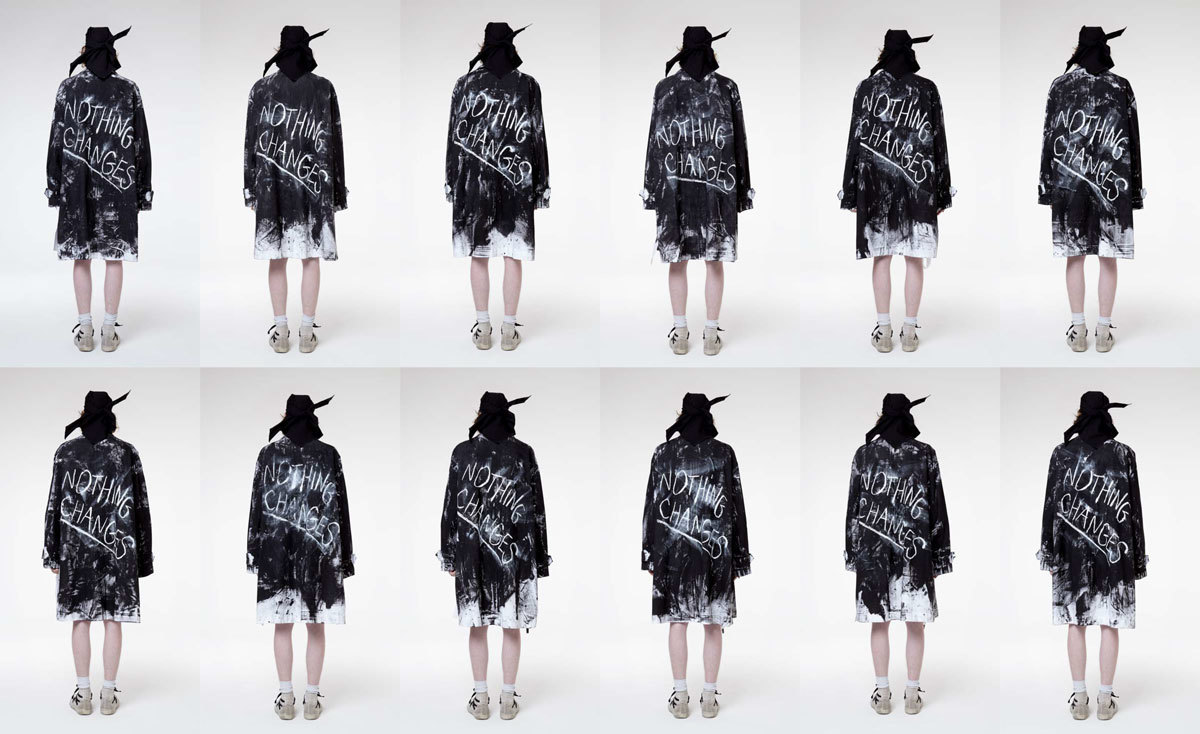Last month, promising fashion designer Tigran Avetisyan presented his new collection in Paris. As I scrolled through the lookbook, which arrived in my inbox to mark this occasion, I realized that what Tigran had presented was a slap in the face to an industry obsessed by newness. The collection was titled In loving memory of Spring Summer 2014 by Tigran Avetisyan and consisted of twelve completely identical coats, he’d originally designed for spring/summer 14. On the back of each, over a thick layer of black paint, was daubed “Nothing Changes.”
“Like all of my previous collections, this one is a comment on the state of fashion,” Avetisyan explains. “The main question I wanted to raise was what is the value of creativity in a marketing-driven industry. Hence I abstained from designing altogether and focused on creating a strong image that will look nice on Instagram.” The fast pace of the industry, tough production schedule, pressure from the buyers, the superficial nature of attention from the press — all the struggles of an emerging fashion designer came together in this statement.
What’s so shocking is that it’s a statement that comes from someone with such a perfect CV. Avetisyan graduated from Central Saint Martins in 2012, was granted LVMH scholarship, and his clothes are now available at Opening Ceremony, 10 Corso Como, and Machine-A among other respected retailers. Maybe it’s because of Tigran’s obvious talent that he felt comfortable making such an anti-business statement.

He’s not alone, though. This year we’ve seen a rise in criticism of the current fashion system, and it’s coming from all quarters — the established, recognized and successful, as well as those just starting out. There are too many clothes in the world, and the endless cycle of consumption has led us to major economical and ecological crisis. Clearly, it’s time for the new generation of designers to ask the question: how can we do things differently? Avetisyan is not alone; this year a few designers voiced their plans to change the way they create, showcase and operate as a business to free themselves from the draining and unnecessary race.
In April Nasir Mazhar — who’s been injecting new energy and much-needed diversity into the London’s fashion scene since his debut in 2006 — announced that he is planning to stop selling through stockists (which he has in 14 countries). “We’ll be selling almost 100% directly online”, he said in an interview with LOVE magazine. “And then we’ll have a shop here open every weekend. We’ll have one-off pieces or brand new collection pieces or whatever. We can produce whatever we want.” Breaking off from retail is a huge risk for Mazhar’s business, yet he believes it would allow him to create more experimental, good quality product in its own time, instead of producing huge quantities of commercially successful pieces stamped with his logo. “Personally I want fashion to go properly independent again, with people doing progressive things, things that’ll make people think a bit more, rather than be confined to this existing system,” he added.
Another London designer, Claire Barrow, has made a decision to cease showing seasonal collections at fashion week in favor of focusing on her creative practice. “Claire will continue to work on a range of her own creative projects,” she announced in a press release, “and is looking to take the chance to really look at the way her work is presented and how she can develop in myriad ways, for the moment outside of the fashion week cycle.” Barrow’s DIY creations, culturally and politically engaging and saturated with energy of youth culture, have always existed between fashion and art (she also had a solo exhibition at London’s M. Goldstein Gallery in April). Her decision once again poses the question, is the divide of creative spheres even necessary? And is the fast paced world of fashion worth all the mental challenges? For Barrow, definitely not.

Of course, we can’t escape talking about fashion latest visionaries, Demna and Guram Gvasalia, who are challenging the industry both creatively and commercially. Vetements staged its latest show in a luxury shopping mall during couture fashion week in Paris, bringing its menswear and womenswear together on one catwalk, combining its work with that of numerous other brands, from Reebok to Manolo Blahnik. Its success proves that the century-old hierarchy is crumbling. Demna never shies away from comments on the pace of fashion and the overwhelming amount of garments produced. “All the corporate luxury brands are trying to be like Zara, which is absurd and impossible,” he said in an interview with 032c.”What gets lost in all this is that, to make something that makes sense, you need time. You need the mental space to assess if someone out there actually needs the Nth dress you’re making, or if it’s being produced just because some brand manager thinks it needs to be in stores, when in fact it will end up on the sales rack, or burned. That pressure is one of the many things we were questioning when we started Vetements.” In attempts to keep the increasingly popular brand independent and unique, Vetements now has limited stockists. Even its collaboration with 18 brands for the latest collection (Brioni for tailoring, Comme des Garçons Shirt for shirting, Manolo Blahnik for heels, Schott for leather jackets, Alpha Industries for bombers, etc) could be seen as an homage to often under-appreciated craftsmanship and the fact that all this amazing stuff, reinvented by Gvasalia’s team, actually already existed in the world.
We live in an era undergoing a major capitalist crisis when everything is cheaper and is produced faster than it should. It is partly our own fault: we were trained to want, to get, to throw away making space for the new. It’s not too late to change: to invest into integrity and creativity, to treasure what you acquire, to empower designers in their efforts to create change. Dame Vivienne Westwood once summed up the new consumer philosophy very well: “Buy less. Choose well. Make it last. Quality, not quantity.” We hardly ever think how this choice affects those working in fashion, but it echoes on the other end: “Make less. Make well. Make it last. Quality, not quantity”
Credits
Text Anastasiia Fedorova
